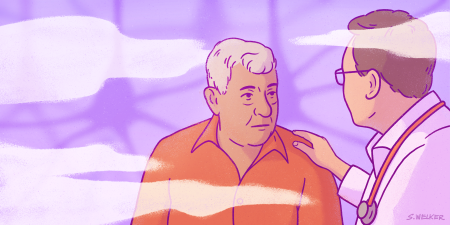Abstract
International medical graduates (IMGs) tend to choose careers in geriatric psychiatry likely because high-quality training and robust mentorship opportunities from other IMGs are available. Geriatric psychiatry offers stable career prospects and opportunities to express humanitarian impulses by working closely with elders. IMGs currently constitute almost a quarter of the psychiatry workforce and approximately 53% of the geriatric psychiatry work force in the United States. However, the number of IMGs entering psychiatry residencies—and, subsequently, geriatric psychiatry fellowships—has recently declined. Overreliance on IMGs in the US geriatric psychiatric workforce means these shortages will further burden an already-limited geriatric mental health care workforce and further compromise US health system capacity to meet its elders’ needs.
A Subspecialty Since 1989
Although there are different definitions of a geriatric or older adult, in the United States, the traditional definition is someone who is at least 65 years of age (ie, Medicare eligible).1 In 2019, there were 54.1 million older adults in the United States, representing 16% of the total population.2 The population of older adults in the United States is expected to grow to 80.8 million, or 21.6% of the total population, by 2040.2
Psychiatric disorders are not uncommon among older adults in the United States, with 1 in 5 individuals over age 55 having a diagnosable disorder.3,4 Based on a 2004-2005 survey, the most common psychiatric disorders in adults age 55 and older were personality disorders (14.5%), anxiety disorders (11.4%), mood disorders (6.8%), and substance use disorders (3.8%).5 In 2016, approximately one-third of older adults were reported to suffer from mild cognitive impairment or dementia and resulting neuropsychiatric symptoms.6 The number of older adults in the United States with Alzheimer’s disease is expected to rise from 4.7 million in 2010 to 13.8 million by 2050.7
Geriatric psychiatry is a subspeciality of psychiatry involved in the practice of caring for older adults with psychiatric disorders.1 The American Association for Geriatric Psychiatry (AAGP), the national association for geriatric psychiatry, was established in 1978.3 The American Board of Psychiatry and Neurology constituted a committee in November 1989 to officially establish the field of geriatric psychiatry as a subspecialization in psychiatry and to identify properly trained and experienced geriatric psychiatrists.8 This article examines the participation of international medical graduates (IMGs) in the US geriatric psychiatric workforce and argues that their declining numbers will further burden an already-limited geriatric mental health care workforce and further compromise US health system capacity to meet its elders’ needs.
International Medical Graduates and the Psychiatry Workforce in the United States
An IMG in the United States is any physician who has obtained their primary medical degree outside the United States or Canada.9 Presently, IMGs represent 23.3% of the total active US physician workforce and 29.2% of the psychiatry workforce.10 The largest group of active IMGs in psychiatry comprises US citizens (22.7%), also referred to as US-IMGs at the time of their entry into medical school. Approximately 20.6% of residents in US psychiatry residency programs are IMGs.11 IMGs in psychiatry are nearly 2 years older than their US counterparts and are more likely to work in the public sector and receive a larger proportion of their income from Medicare and Medicaid.10 IMGs in psychiatry are less likely to work as administrators or medical teachers and more likely to work as full-time hospital staff or locum tenens physicians than their US counterparts.10 Those who choose an academic career are less likely to obtain leadership positions.12 Occupying positions of lower prestige, IMGs “encounter biases and microaggressions and lack support groups and mentors.”12
Recently, significant changes have occurred in the number of IMG physicians entering the US psychiatry workforce.13 Among all major medical specialties, psychiatry has had the largest relative decrease in the number of IMG physicians matched from 2014 to 2020 (46.3%),13 which has subsequently reduced the pool of IMGs who can enter psychiatry subspecialties, including geriatric psychiatry. An important reason for this decline is increased interest in psychiatry among American medical graduates (AMGs), as reflected in growing numbers of AMGs entering psychiatry residency programs between 2015 and 2019.14
Why IMGs Choose Geriatric Psychiatry
IMGs represent 52% of the geriatric psychiatry workforce in the United States.10 This number is significantly greater than what has been noted in other subspecialities of psychiatry, including forensic psychiatry (21%), child and adolescent psychiatry (29.6%), psychosomatic medicine (31%), and addiction psychiatry (41.1%).10
Surveys of international medical graduates indicate that they may harbor more favorable cultural and societal attitudes toward elderly patients.
Although there is no empirical data on why IMGs preferentially choose a career in geriatric psychiatry, factors associated with psychiatric residents’ interest in geriatric psychiatry as a field of specialization could offer some insight. One cross-sectional online survey of Canadian psychiatry residents found that the variables that were robustly associated with an interest in geriatric psychiatry were “completion of geriatric psychiatry rotation(s) before the third year of residency,” “comfort working with geriatric patients and their families,” “positive experiences caring for older adults prior to medical school,” and “the presence of annual conferences in the resident’s field of interest.”15 Moreover, geriatric psychiatry fellowships with more geriatric psychiatry faculty can provide role models and mentors.16 Furthermore, access to a robust pipeline scholarship program that provides greater understanding of the field of geriatric psychiatry in addition to offering excellent mentorship during psychiatry residency (eg, the AAGP Scholars Program) possibly attracts IMGs to geriatric psychiatry.16,17
In addition, non-US IMGs often come from countries and cultures where older adults are an important part of the extended and multigenerational family structure and therefore may experience greater comfort and confidence in working with older adults, even those with psychiatric disorders. Surveys of IMGs indicate that they may harbor more favorable cultural and societal attitudes toward elderly patients. Geriatric psychiatry fellows with a career interest in geriatric psychiatry have reported that personal relationships and experiences with seniors, as well as cultural attitudes, influenced their interest.18 They also identified respect for elders, enjoying their life stories, and believing it is society’s responsibility to care for the elderly as inherent in their choice of career.18
Need for IMGs
Currently, there are approximately 64 Accreditation Council for Graduate Medical Education (ACGME)-approved geriatric psychiatry fellowship programs in the United States.19 However, the proportion of IMGs in geriatric psychiatry fellowships has declined from the decade 2000 to 2010, when more than 50% of the geriatric psychiatry fellowship slots were taken by IMGs, to 37% in 2021.18,19 This decline is most likely a reflection of the decreasing number of IMGs matching into psychiatry residencies and therefore a lower number of them available to apply for fellowships. While AMGs have a higher match rate into psychiatry residencies than IMGs, the number of geriatric psychiatry fellows declined between 2015 and 2019,14 the reasons for which are not clear. Specifically, the number of trainees entering geriatric psychiatry fellowships fell by 27.6% between 2015 and 2019, as compared to a 2.5% decline in addiction psychiatry fellows and a growth of 11.1% in forensic psychiatry fellows, 7.6% in child and adolescent fellows, and 8.9% in consultation-liaison fellows during the same period.14 The 2019 fill rate for the geriatric psychiatry fellowship programs was 29.5%, down 8.6% from 2017.14 In 2021-2022, there were only 55 geriatric psychiatry fellows in the United States.18 If the current trend of decreasing numbers of AMGs and IMGs going into geriatric psychiatry continues, the geriatric psychiatry workforce is bound to decrease.
As the population of older adults in the United States becomes increasingly racially diverse,20 another important benefit of the significant presence of IMGs, especially non-US IMGs, is that they often provide services to minority and socioeconomically challenged older adults. Assuming that non-US IMGs contribute to the diversity of the workforce, given that IMGs still compose the majority of the geriatric psychiatry workforce,10 the trend of decreasing numbers of IMGs entering psychiatry and subsequently geriatric psychiatry could present challenges with respect to the long-term concordance of patient-clinician characteristics (eg, race, ethnicity, language).12 Creating a more diverse physician workforce has been the goal of many organizations, with much greater attention to race, ethnicity, gender, and sexual identity than to country of origin. IMGs add to that diversity, often providing medical services to patients of the same racial/ethnic background. It could be stated that the overreliance on IMGs has actually led to a more diverse geriatric psychiatry workforce, which has benefitted the increasingly diverse population of older adults in the United States.
Conclusion
The field of geriatric psychiatry in the United States is at a crossroads at the present time.15 On the one hand, the need for geriatric psychiatrists has continued to grow significantly, but despite this growing demand, the number of geriatric fellows in the United States has shown a remarkable decline since 2001-2002.14,21 The reasons for this decline are numerous, including a lack of financial incentives to embark on a career in geriatric psychiatry.22 Other reasons may include lack of exposure to geriatric psychiatry or geriatric psychiatrists during medical school and the early part of residency.16 As the number of IMGs matched into US psychiatry residencies continues to decline, the number of these trainees choosing a career in geriatric psychiatry will also decline. The result will be a substantial shrinkage in the pool of practicing IMG geriatric psychiatrists in the United States, which will worsen the burden of care of older adults with psychiatric disorders and reduce the diversity of the geriatric psychiatry workforce.
To avert this looming health care crisis, the federal government must act promptly to incentivize the choice of geriatric psychiatry as a specialty among psychiatric trainees and additionally encourage the recruitment of IMGs into psychiatry residency programs, which would increase the number of graduates entering geriatric psychiatry fellowships and subsequently the number entering the US geriatric psychiatry workforce. To address the issue of diversity of the geriatric psychiatry workforce, active efforts should be made to recruit underrepresented minorities into medical schools and psychiatric residencies, in addition to continued recruitment of IMGs.23 To increase the number of trainees going into geriatric psychiatry fellowships, efforts would need to be made by residency programs to recruit and retain geriatric psychiatric faculty to help develop geriatric psychiatry curricula, provide early exposure to geriatric psychiatry, and provide mentorship in the field to medical students and residents.16,18,21 Other strategies to enhance recruitment could include desensitizing trainees to ageist biases, identifying those trainees with favorable attitudes and experiences, and educating them about geriatric psychiatric practice and opportunities. The potential barrier of student debt to subspecialty training for general and academic career tracks also needs to be addressed. Loan forgiveness programs may help in this regard. In addition, measures such as increased reimbursement for patient care services, improved pay packages, improvement in workplace environment, and optimal working hours may be needed not only to bridge the diversity gap in the geriatric psychiatry workforce but also to proportionally increase the overall workforce.
References
- Grossberg GT. Geriatric psychiatry—an emerging specialty. Mo Med. 2010;107(6):401-405.
-
Administration for Community Living. 2020 profile of older Americans. US Department of Health and Human Services; 2021. Accessed September 18, 2022. https://acl.gov/sites/default/files/Aging%20and%20Disability%20in%20America/2020ProfileOlderAmericans.Final_.pdf
- Tampi RR. Learning from the past and creating the future: American Association for Geriatric Psychiatry (AAGP) and geriatric mental healthcare in the United States. Am J Geriatr Psychiatry. 2019;27(12):1421-1427.
-
Centers for Disease Control and Prevention; National Association of Chronic Disease Directors. The state of mental health and aging in America: what do the data tell us? National Association of Chronic Disease Directors; 2008. Accessed May 23, 2023. https://www.cdc.gov/aging/pdf/mental_health.pdf
- Reynolds K, Pietrzak RH, El-Gabalawy R, Mackenzie CS, Sareen J. Prevalence of psychiatric disorders in US older adults: findings from a nationally representative survey. World Psychiatry. 2015;14(1):74-81.
- Manly JJ, Jones RN, Langa KM, et al. Estimating the prevalence of dementia and mild cognitive impairment in the US: the 2016 Health and Retirement Study Harmonized Cognitive Assessment Protocol Project. JAMA Neurol. 2022;79(12):1242-1249.
- Hebert LE, Weuve J, Scherr PA, Evans DA. Alzheimer disease in the United States (2010-2050) estimated using the 2010 census. Neurology. 2013;80(19):1778-1783.
-
Geriatric psychiatry. American Board of Psychiatry and Neurology, Inc. Accessed March 29, 2023. https://www.abpn.com/become-certified/taking-a-subspecialty-exam/geriatric-psychiatry/
- Ahmed AA, Hwang WT, Thomas CR Jr, Deville C Jr. International medical graduates in the US physician workforce and graduate medical education: current and historical trends. J Grad Med Educ. 2018;10(2):214-218.
- Duvivier RJ, Buckley PF, Martin A, Boulet JR. International medical graduates in the United States psychiatry workforce. Acad Psychiatry. 2022;46(4):428-434.
- Brotherton SE, Etzel SI. Graduate medical education, 2019-2020. JAMA. 2020;324(12):1230-1250.
- Zaidi Z, Dewan M, Norcini J. International medical graduates: promoting equity and belonging. Acad Med. 2020;95(12)(suppl):S82-S87.
- Virani S, Mitra S, Grullón MA, Khan A, Kovach J, Cotes RO. International medical graduate resident physicians in psychiatry: decreasing numbers, geographic variation, community correlations, and implications. Acad Psychiatry. 2021;45(1):7-12.
-
2020 resident/fellow census. American Psychiatric Association. September 2022. Accessed March 28, 2023. https://www.psychiatry.org/getmedia/83395957-9a49-47f2-9c19-02c636f2a368/APA-Resident-Census-2020.pdf
- Rej S, Laliberté V, Rapoport MJ, Seitz D, Andrew M, Davidson M. What makes residents interested in geriatric psychiatry? A Pan-Canadian online survey of psychiatry residents. Am J Geriatr Psychiatry. 2015;23(7):735-743.
- Conroy ML, Meyen RA, Slade MD, Forester BP, Kirwin PD, Wilkins KM. Predictors for matriculation into geriatric psychiatry fellowship: data from a 2019-2020 national survey of US program directors. Acad Psychiatry. 2021;45(4):435-439.
- Conroy ML, Yarns BC, Wilkins KM, et al. The AAGP Scholars Program: predictors of pursuing geriatric psychiatry fellowship training. Am J Geriatr Psychiatry. 2021;29(4):365-374.
- Agapoff JRT 4th, Maixner S, Takeshita J, Nikogosyan G, Kirwin P. A survey of geriatric psychiatry fellows and program directors: specialty choice, program choice, and program quality. Acad Psychiatry. 2022;46(4):455-459.
-
Geriatric psychiatry (P). American Medical Association. Accessed March 27, 2023. https://freida.ama-assn.org/specialty/geriatric-psychiatry-p
-
Trinh NT, Bernard-Negron R, Ahmed II. Mental health issues in racial and ethnic minority elderly. Curr Psychiatry Rep. 2019;21(10):102.
- Bragg EJ, Warshaw GA, Cheong J, Meganathan K, Brewer DE. National survey of geriatric psychiatry fellowship programs: comparing findings in 2006/07 and 2001/02 from the American Geriatrics Society and Association of Directors of Geriatric Academic Programs’ Geriatrics Workforce Policy Studies Center. Am J Geriatr Psychiatry. 2012;20(2):169-178.
- Juul D, Colenda CC, Lyness JM, Dunn LB, Hargrave R, Faulkner LR. Subspecialty training and certification in geriatric psychiatry: a 25-year overview. Am J Geriatr Psychiatry. 2017;25(5):445-453.
- Khan S, Saboor S, Naveed S, et al. Gender and racial trends among geriatric psychiatry fellows in the USA: a call to action. Psychiatr Q. 2022;93(2):559-570.



